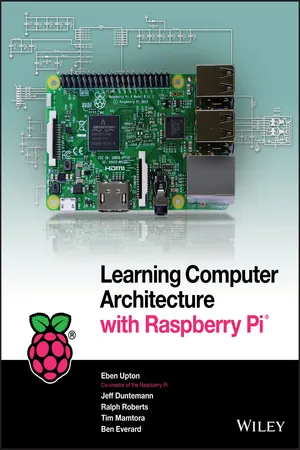
Learning Computer Architecture with Raspberry Pi
- English
- ePUB (mobile friendly)
- Available on iOS & Android
Learning Computer Architecture with Raspberry Pi
About this book
Use your Raspberry Pi to get smart about computing fundamentals
In the 1980s, the tech revolution was kickstarted by a flood of relatively inexpensive, highly programmable computers like the Commodore. Now, a second revolution in computing is beginning with the Raspberry Pi. Learning Computer Architecture with the Raspberry Pi is the premier guide to understanding the components of the most exciting tech product available. Thanks to this book, every Raspberry Pi owner can understand how the computer works and how to access all of its hardware and software capabilities.
Now, students, hackers, and casual users alike can discover how computers work with Learning Computer Architecture with the Raspberry Pi. This book explains what each and every hardware component does, how they relate to one another, and how they correspond to the components of other computing systems. You'll also learn how programming works and how the operating system relates to the Raspberry Pi's physical components.
- Co-authored by Eben Upton, one of the creators of the Raspberry Pi, this is a companion volume to the Raspberry Pi User Guide
- An affordable solution for learning about computer system design considerations and experimenting with low-level programming
- Understandable descriptions of the functions of memory storage, Ethernet, cameras, processors, and more
- Gain knowledge of computer design and operation in general by exploring the basic structure of the Raspberry Pi
The Raspberry Pi was created to bring forth a new generation of computer scientists, developers, and architects who understand the inner workings of the computers that have become essential to our daily lives. Learning Computer Architecture with the Raspberry Pi is your gateway to the world of computer system design.
Frequently asked questions
- Essential is ideal for learners and professionals who enjoy exploring a wide range of subjects. Access the Essential Library with 800,000+ trusted titles and best-sellers across business, personal growth, and the humanities. Includes unlimited reading time and Standard Read Aloud voice.
- Complete: Perfect for advanced learners and researchers needing full, unrestricted access. Unlock 1.4M+ books across hundreds of subjects, including academic and specialized titles. The Complete Plan also includes advanced features like Premium Read Aloud and Research Assistant.
Please note we cannot support devices running on iOS 13 and Android 7 or earlier. Learn more about using the app.
Information
The Shape of a Computer Phenomenon
Growing Delicious, Juicy Raspberries
- Eben Upton
- Rob Mullins
- Jack Lang
- Alan Mycroft
- Pete Lomas
- David Braben
- Raspberry Pi (Trading) Ltd. performs engineering and sales, with Eben Upton as CEO.
- The Raspberry Pi Foundation is the charitable and educational part.
www.raspberrypi.org (see Figure 1-1) presents the impetus that resulted in the Raspberry Pi. This is what they say on the About Us page: The idea behind a tiny and affordable computer for kids came in 2006, when Eben Upton, Rob Mullins, Jack Lang and Alan Mycroft, based at the University of Cambridge’s Computer Laboratory, became concerned about the year-on-year decline in the numbers and skills levels of the A Level students applying to read Computer Science. From a situation in the 1990s where most of the kids applying were coming to interview as experienced hobbyist programmers, the landscape in the 2000s was very different; a typical applicant might only have done a little web design.

System-on-a-Chip

Table of contents
- Cover
- Title Page
- Table of Contents
- Introduction
- Chapter 1: The Shape of a Computer Phenomenon
- Chapter 2: Recapping Computing
- Chapter 3: Electronic Memory
- Chapter 4: ARM Processors and Systems-on-a-Chip
- Chapter 5: Programming
- Chapter 6: Non-Volatile Storage
- Chapter 7: Wired and Wireless Ethernet
- Chapter 8: Operating Systems
- Chapter 9: Video Codecs and Video Compression
- Chapter 10: 3D Graphics
- Chapter 11: Audio
- Chapter 12: Input/Output
- End User License Agreement